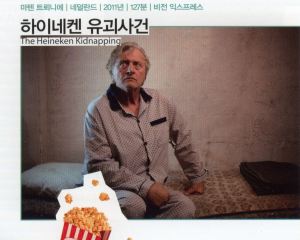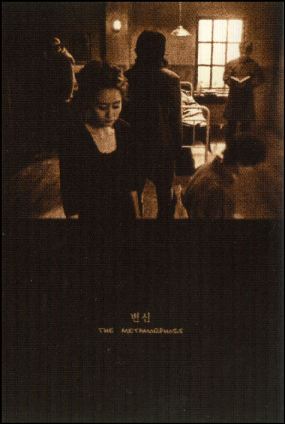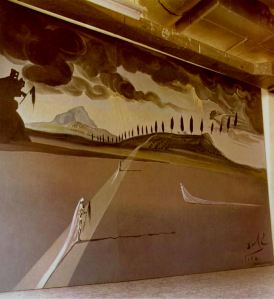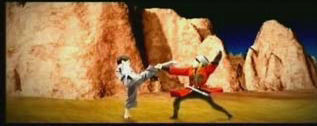Are You Sitting Comfortably? Part I
 In this edition of World On Film, I look back over my visit to the recent Puchon International Fantastic Film Festival (Pifan), and give quick takes on the screenings I managed to catch.
In this edition of World On Film, I look back over my visit to the recent Puchon International Fantastic Film Festival (Pifan), and give quick takes on the screenings I managed to catch.
I’d been wanting to catch Pifan for a few years now, but always somehow managed to forget when it was on. However, after the complete debacle that was BIFF 2011, it was time to get serious about it. For those wondering, Pifan takes place in Bucheon, a city in the Korean province of Gyeonggi, located roughly halfway between Seoul and Incheon. There are eight categories, including World Fantastic Cinema, Ani-Fanta, and Fantastic Short Films. Only one category, Puchon Choice, is competitive, with the winners being screened on the final weekend of the festival. This is Pifan’s 16th year, making it almost as long as its counterpart in Busan.
Physically-speaking, Pifan is smaller than BIFF, and organised much the way BIFF used to be, ie – with screenings sanely distributed across in a number of cinemas throughout downtown Bucheon with one particular venue, Puchon Square, at the centre. It has yet to become the almost industry-only event that is BIFF today, which in practical terms means the average joe can actually get tickets for this thing both online or by simply turning up to the ticket offices in timely fashion. There’s no insane queuing for hours, no giant department store you have to trek through with huskies just to reach a screening, nor the feeling that if you aren’t press or industry, you’re getting in everyone’s way.
On the flipside of this, Bucheon is hardly the most exciting city to hold a festival, the main street seems to be in a permanent state of construction, and the more modest department stores in which the cinemas are located don’t have the greatest selection of cuisine. On balance however, I had a very positive experience, so I aim to make the best of Pifan until it inevitably becomes so successful that getting tickets for screenings will become as difficult as convincing Adam Sandler to stop making movies.
I managed to catch something from most of the categories mentioned during my visit. Here is what I saw:
Hard Labor
(Brazil, 2011) Written & Directed by Marco Dutra and Juliana Rojas
Sao Paolo housewife Helena is about to realise her dream of starting her own business in the form of a neighborhood supermarket. Yet just as she is about to sign the papers for the property lease, her husband, Otavio, is fired from his job as an insurance executive after ten years’ faithful service. However, the couple decides to risk the investment and the store opens, though for some reason, business just doesn’t seem to be taking off, seemingly in direct proportion with Otavio’s failure to find work and mounting alienation from the family. As an increasingly-stressed Helena struggles to hold everything together, she finds her attention drawn to a crumbling supermarket wall and wonders whether it might hold the answers to her problems.
“There’s no insane queuing for hours, no giant department store you have to trek through with huskies just to reach a screening, nor the feeling that if you aren’t press or industry, you’re getting in everyone’s way.”
For much of its screen time, Hard Labor is more a drama about family breakdown than it is a horror movie, which is especially important for horror fans to bear in mind when going into it. Although there are definitely supernatural elements to the story, they are there to be allegorical, to act as a catalyst for the primarily human conflict which takes place. The problem for me at least is that neither of these elements quite reach the crescendo they could have had and there is a little too much stillness throughout. It isn’t really until the final scene that I felt the two strands really came together, but that does mean that Hard Labor has a satisfying ending. Anyone who’s ever had to face long-term unemployment through no fault of their own will appreciate the film’s central message that to get by in this ultra-competitive world, you sometimes have to unleash the inner animal. Good casting choices, lighting, and set construction also help to push Hard Labor over the line, along with the occasional dash of dark humour.
The Heineken Kidnapping
(Netherlands, 2011) Directed by Maarten Treurniet Written by Kees van Beijnum & Maarten Treurniet

Rutger Hauer stars in Maarten Treurniet’s interpretation of ‘The Heineken Kidnapping’ (image: Pifan Daily)
As its title suggests, The Heineken Kidnapping retells the true-life incident when in 1982, Alfred Heineken, then-president of the family business, was kidnapped by four individuals for the ransom money. Based loosely on the events as reported by Peter R. de Vries, the film focuses on the careful planning, abduction, and aftermath of the event, in which the traumatised Heineken struggles to cope with his imprisonment as well as fight various legal loopholes in order to bring the criminals to justice.
Since its release, the film has been criticised for playing fast and loose with the facts of the case, as well as glossing over the highly meticulous planning the four young men undertook before making their move. I therefore probably had the advantage of ignorance, in that I had never heard of the kidnapping before, and simply took what I saw at face value. To me, The Heineken Kidnapping was a fairly compelling crime drama with a strong cast, most notably in the form of Reinout Scholten van Aschat as the psychopathic young Rem Humbrechts, for whom the operation is as much for sadistic pleasure as it is for financial gain. Meanwhile Rutger Hauer turns in a strong and sympathetic performance as Alfred Heineken himself, which, given that the audience is being asked to care about the plight of an extremely wealthy adulterer, is a testament to the actor’s longstanding talent. Those more familiar with the source material may feel differently, but for me at least, The Heineken Kidnapping was an enjoyable example of Dutch cinema, and proved to be one of the more talked-about entries at Pifan – at least going by some of the people I met during my visit.
Extraterrestrial
(Spain, 2011) Written & Directed by Nacho Vigolondo
When a series of flying saucers begin hovering over the cities of Spain, most of the population takes to the hills. However, for Julio, a young advertising artist in Cantabria, the more pressing concern is to stay as close to Julia, the girl of his dreams, in whose apartment he has just spent a passionate evening. Unfortunately, matters are complicated by the presence of Julia’s nosy next-door neighbour and the return of her longtime boyfriend. But Julio will do anything to be with the girl he loves – even if that means making up a convoluted series of lies about an alien invasion – just to stay on the premises.
“At its core, Extraterrestrial is really a pretty conventional romance-comedy that hits all the usual notes its well-worn formula demands.”
With dramatic shots of a saucer hovering above urban skyscrapers and dire warnings by the authorities to stay out of harm’s way, one could be forgiven for thinking that Extraterrestrial might be another District 9. However, as with Hard Labor, the fantastical elements of the script serve merely to push a group of individuals together into a confined space and add colour to the background. At its core, Extraterrestrial is really a pretty conventional romance-comedy that hits all the usual notes its well-worn formula demands, and the unusual setting little more than an elaborate misdirection. That said, it is a pleasing enough 90 minutes with some enjoyable humour, and Julian Villagran makes for an unconventional romantic lead. Nonetheless, would-be viewers are advised to set their phasers on ‘low expectations’ for the best result.
Spellbound (aka Chilling Romance)
(South Korea, 2011) Written & Directed by Hwang In-ho
Yuri, a shy young woman living in Seoul, is haunted by the ghost of her dead schoolfriend who lost her life during an ill-fated class excursion. Desperate for human company, Yuri has resigned herself to the fact that she will never enjoy close friendships or romance as long as a malignant ghost frightens away anyone who comes near. Hope comes in the form of Jogu, a wealthy stage magician who becomes intrigued by Yuri after he hires her for his illusionist act. With everyone else running from her in fear, will Jogu’s affection for his star performer be strong enough to overcome resistance from the Other Side?
I’d been warned before the screening began that Spellbound was something of a corn-fest, and by the end credits, felt so overdosed on saccharine, I nearly checked myself into a medical clinic for a diabetes test. In a country where clichéd melodrama is so popular it’s a major international export, Spellbound does not stand out from the crowd. With every passing minute came cliché after tired cliché about ill-fated romance, and every stomach-churning line about love and dreams meticulously welded to a truly nauseatingly-twee soundtrack had me twisting in my seat and groaning like an old man putting Viagra to use for the first time. If Extraterrestrial was formulaic, Spellbound was the formula, right down to the wise-cracking but experienced friends and sidekicks of the lead characters. All of which was so overwhelming that the horror element to the story, and raison d’etre for the whole situation was never adequately built up to be anything especially convincing and had me longing for the Dementors to float in on special dispensation from Azkaban and suck everyone’s souls into oblivion. Son Yeji gave a creditably agonised performance as the long-persecuted female lead, but frankly, the entire cast could have simply sat in a pool filled with corn syrup and elicited the same drippy performance. That, at least, would have been more honest.
Fantastic Short Films 7

Postcard for the Korean short film ‘The Metamorphosis’, handed out to patrons as they entered the cinema for the ‘Fantastic Short Films 7’ collection.
The great thing about short film collections is that if one film proves awful, you don’t have to wait long for the next one. FSF7 however started strong, with the Korean entry Delayed, in which a young middle-aged woman waits patiently at a near-deserted train station for her husband to arrive. Yet as she strikes up a conversation with an inquisitive man claiming also be expecting an arrival, nothing seems to be quite as it appears. Cast and crew of this very moving short appeared live on stage at the end, where director Kim Dong-han explained his desire to connect lost souls with lost train stations. My thanks to the Pifan personal interpreter who sat with me during this unexpected bonus event!
Next up, the Japanese parody-pastiche Encounters, wherein two very good friends look for adventure in the countryside and find more than they bargain for with giant monsters roaming the streets thanks to the machinations of an evil professor. Shot entirely using plastic action figures and some deliberately wonky props and sets, Encounters is a tongue-in-cheek Godzilla-like comedy, complete with lame action sequences and bad dialogue. I’d like to think the English subtitles weren’t meant to be quite as poor as they were, but if so, mission accomplished!
“The quality then takes a serious nosedive with the unpleasant and forgettable Italian horror mish-mash, I’m Dead, and I certainly wished I’d been dead during the 17 minutes it screened.”
The quality then takes a serious nosedive with the unpleasant and forgettable Italian horror mish-mash, I’m Dead, and I certainly wished I’d been dead during the 17 minutes it screened. Two long-time friends out hiking in the forest suddenly find themselves kidnapped by a crazed religious fanatic who begins torturing them in his secret underground lair, replete with bad lighting, corpses and handy tunnel system. The pointless and gruesome tale offers no depth in terms of the reasons behind the mad psychopath, nor indeed the ridiculous twist at the end. Which is an interesting coincidence, because I can offer no reason why anyone should watch it.
The macabre continues – though in a very different style – in the form of the Korean silent film, The Metamorphosis, a shadowy sepia affair with the disconcerting performances of Eraserhead and the visual echoes of Nosferatu. Claustrophobic static shots combine with heavy industrial clanking and retro white-on-black dialogue text inserts to tell the story of a family beset by vampirism. In truth, it’s a great example of style over substance that adds little storywise to the genre and comes close at one point to mobs with burning torches. Yet it’s the style that proves the most compelling here, so that while I’m not entirely sure what I saw, it was impossible to take my eyes off the screen. There are plenty of music videos like that.
Rounding out the collection was the light-hearted martial arts/crime spectacular, Pandora, in which taekwondo trainee Jeong Hun arrives in the city of Chungju for a performance, only to accidentally switch his cell phone with that of a man on the run from a gang intent on seizing the secrets the identical device contains. The film is a fairly unremarkable, reasonably-paced runaround that could not possibly satisfy fans of martial arts films, offering nothing new by way of story or visuals. When a story is full of clichés that have been done better elsewhere, you have to wonder who the intended audience really is. As a 30-minute romp in a film festival, Pandora is sufficient eye candy, but on its own, it swims in crowded waters.
*****
Next Time
The second half of my Pifan retrospective. I finally get to see Stanley Kubrick’s The Shining on the big screen, watch the over-reaching new documentary about the very same, entitled Room 237, find myself underwhelmed by the new Harold & Kumar-style American feature, 3-2-1…Frankie Go Boom and sit through another short film collection with mixed results. That’s World On Film next time.
No Mercy
World On Film goes all-Azerbaijan, all the time this week with a double feature. First up is the uncomplicated but lighthearted enjoyable fluff of Bu da belə, followed by the full-length ‘straight-to-video’ terribleness that is Şeytanın Tələsi. Just what do these two untranslated titles mean? Read on…
Bu da belə
(2009) (Director unknown)
Bu da belə, or ‘That’s It’, as it translates into English, is a lightly amusing short film, running just over 3 minutes, about a man struggling to bring his girlfriend a new television for her birthday up the stairs of her rather dilapidated urban apartment in the absence of a functioning elevator. With the many obstacles he encounters on the way up, I couldn’t help but be reminded of Donkey Kong. The film’s title is taken from the last line of dialogue, which neatly sums up his ordeal. I once had to spend a day helping relatives move furniture in and out of their 3rd-floor apartment that was equally devoid of elevators, so I know exactly how he feels. The short runs at just about the right length given the premise and star performer Qurban Ismayilov has a good, expressive face for what is essentially a visual comedy. Nəsibə Eldarova plays the girlfriend. The film was made in 2009 and is actually quite easy to find online if you look in the obvious places. You’d be ill-advised to bother doing so with the next feature, however.
“I couldn’t help but be reminded of Donkey Kong.”
Şeytanın Tələsi
(2006) Directed by Tanriverdi Allahverdiyev
“I warned you many times not to play with the balls of other people.”
I am not a major fan of martial arts films, so when I do watch one, I expect it to have charismatic actors, decent production values and of course spectacular fight scenes. Şeytanın Tələsi, however, contained acting more wooden than a pine chest, the production values of a finger painting and fight scenes seemingly choreographed by a coma patient. I quickly found myself in more pain than anyone having their face rearranged on screen, and constantly fighting the urge to walk away and stare at the wall in search of something more entertaining. Given the many entries in the Azerbaijani film repertoire, I feel sure I simply picked the Middle Eastern equivalent of a Steven Seagal and that there are far better offerings from the Caspian nation waiting for me. In case you’re wondering why I therefore picked this one, it was the only Azeri-language film I could get hold of with English subtitles (The 40th Door has been screened at film festivals, but a copy wasn’t available). Of course I say ‘English’…
Whoever translated Şeytanın Tələsi clearly felt that anything more than a basic understanding of the dialogue would be a great extravagance. For all I know, the film could have had a script written by the Azerbaijani equivalent of Francis Bacon and the washboard-flat performances therein are the result of exquisitely subtle delivery. Not that I believe this for a second, but at the very least, I cannot condemn the writers for the bad dialogue that continually stabbed at my eyes whenever it appeared on screen. This did not always occur when it was supposed to – there were several occasions when lines of dialogue simply weren’t translated – most unbelievably of all during the inevitable climactic fight sequence. “What will be the end of this story?” one character asks with more stiltedness than a man with two artificial legs. ‘No idea,’ I replied from the other side of the glass, rapidly losing the will to live, ‘just so long as it comes soon.’
“I cannot condemn the writers for the bad dialogue that continually stabbed at my eyes whenever it appeared on screen.”
It may therefore come as no surprise that I didn’t fully pin down every nuance of the plot, although not being a cinematic adaptation of Wittgenstein, it wasn’t a total mystery either. Major Vagif Asadov (or Assadov – we are presumably offered two spellings as part of some sort of lexically-symbolic attempt at character depth) is a member of the nation’s equivalent of Special Branch, the FBI, or, given his passing resemblance to Zippy, the Rainbow House. Asadov oversees a sting operation intercepting a drug shipment supplied by Devil Barasa, an underground kingpin. Knowing Barasa will target his family in an act of revenge, Asadov sends his young son Yusif into the care of Azerbaijani karate master Tanrivaldi, who agrees to take his new young protégé into the forest to train him. Unfortunately, Team Barasa gets wind of this and set about the task of retrieving their ‘bargaining chip’. I could elaborate further, but I will avoid spoiling things on the off-chance that someone is mad enough to watch the film for themselves. Suffice to say, some rather dubious karate is involved. And just in case the audience isn’t convinced that Barasa and his henchmen are the villains of the piece, the actors helpfully elicit evil pantomime laughs when events are swinging their way.
One thing about Şeytanın Tələsi that seems abundantly clear to me is the lack of budget. This surely explains the hideous post-production work, to name one of the film’s many crimes. Like many a martial arts feature, sound effects are dubbed over the fight scenes to give them a more visceral feel. Unfortunately, the film’s audio geniuses don’t seem too keen to make them at least halfway-realistic. Swinging fists make swooping sounds like rotating helicopter blades, while connecting fists sound suspiciously like someone punching their own hand. Even more mystifying are the entirely misplaced sounds, such as the sudden swell of running streams and birdsong during a scene where two characters are traversing the busy streets of Baku.
“Swinging fists make swooping sounds like rotating helicopter blades, while connecting fists sound suspiciously like someone punching their own hand.”
Then there’s the musical portion of the soundtrack. Anyone who’s seen an episode of the original Star Trek will know that part of what makes its score so memorable is the repetition of its musical motifs. Typically, a number of cues would be recorded for the season and then repeatedly used throughout according to the action on screen. There were just enough pieces in the tank to cover all the major emotions. However for Şeytanın Tələsi, possibly in a clever attempt at Phillip Glass minimalism, the producers decide to follow the same approach with only two musical cues – one for ‘touching’ scenes, another covering ‘action’ sequences. For 90 minutes. There may have been a third, but since my neighbour was playing a cd at the time, I can’t be too certain. Assuming the viewer isn’t completely sick to death of this musical torture after the first half-hour, they may afterward feel an alarming urge to play something from the Commodore 64 collection. If your film budget can’t stretch to more than a couple of tunes, I’d consider silence as a viable alternative.
Not that silence doesn’t play a part in the story. The film is peppered with long sequences where characters seem to be engaged in discussion, but rather than make the audience privy to their dialogue, we are instead forced to lip-read a muted scene while ‘Music #1’ helpfully reminds us that we are watching two people speak. Halfway through, the dialogue cuts in, the content of which suggesting that whatever the speakers were discussing earlier, it can’t have been anything more than the football scores, as we soon hear their reason for meeting verbalized in full. Still it’s not the first time the director attempts to help the viewer understand what they’re watching, given that he felt the need to have someone state the film’s title while the title card was on screen. A kind perspective might perhaps suggest the muted dialogue scenes are in fact a filmic convention. An accurate one might suggest that Şeytanın Tələsi‘s overseers were struggling to fill up 86 minutes – something I strongly suspect given that the film concludes with a completely unrelated music video in which, via the magic of chroma key, the actor playing Yousef, for no discernible reason, stands against a very fake projected background practicing karate moves while simultaneously performing what I presume is a traditional Azerbaijani dance. How this relates to the drama that preceded it I would imagine can only be determined by transcending to a higher level of consciousness.
“A kind perspective might perhaps suggest the muted dialogue scenes are in fact a filmic convention. An accurate one might suggest that Şeytanın Tələsi‘s overseers were struggling to fill up 86 minutes.”
Mercifully, those 86 minutes do finally come to an end – the fact that they felt more like 586 minutes will scar me for life. Interestingly, when attempting to translate the film’s title, Şeytanın Tələsi would come to read ‘Telecine Of Evil’, or even ‘Satan’s Telecine’. No doubt the overwhelmingly-diligent subtitler would have been more than happy with that (would anyone care to enlighten me as to the actual translation?). If indeed demonic influence was involved, it was entirely successful, though for the wrong reasons.
Instead Of This
 And with that, World On Film comes to the end of this first analytical foray into flickering foreign projections. I’ll be taking time off for about a month to recharge my batteries and catch up on other things strongly neglected. Several film reviews for countries beginning with ‘B’ have already been written, so the tracks are already being laid for the next ‘series’, as it were, which will begin in the warm, watery climes of the Bahamas. This does not however mean the onset of tumbleweeds bouncing with reckless abandon across the blog. I will continue to abuse this sector of cyberspace in the interim with my rambling waffle on matters dubiously connected with the World On Film raison d’etre.
And with that, World On Film comes to the end of this first analytical foray into flickering foreign projections. I’ll be taking time off for about a month to recharge my batteries and catch up on other things strongly neglected. Several film reviews for countries beginning with ‘B’ have already been written, so the tracks are already being laid for the next ‘series’, as it were, which will begin in the warm, watery climes of the Bahamas. This does not however mean the onset of tumbleweeds bouncing with reckless abandon across the blog. I will continue to abuse this sector of cyberspace in the interim with my rambling waffle on matters dubiously connected with the World On Film raison d’etre.
Coming next time therefore, I delve into the world of alternative film soundtracks, or more accurately, one in particular. If you can guess the relationship between a dark, spectral figure haunting a French music hall and a famous English prog rocker, you’ll be halfway there. Plans are also afoot to try and visit the 2010 Pusan International Film Festival next week and if they come to fruition, the blog will be here to provide an autopsy of the journey’s dead and rotting corpse. Don’t quite know where I’m going with this analogy, so I will simply sign off…until next time.









